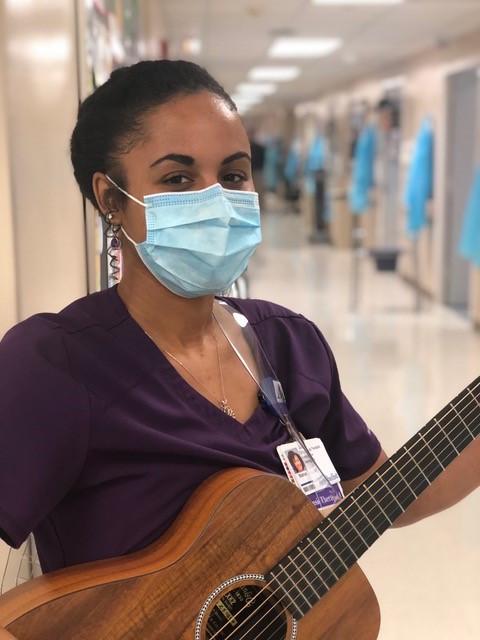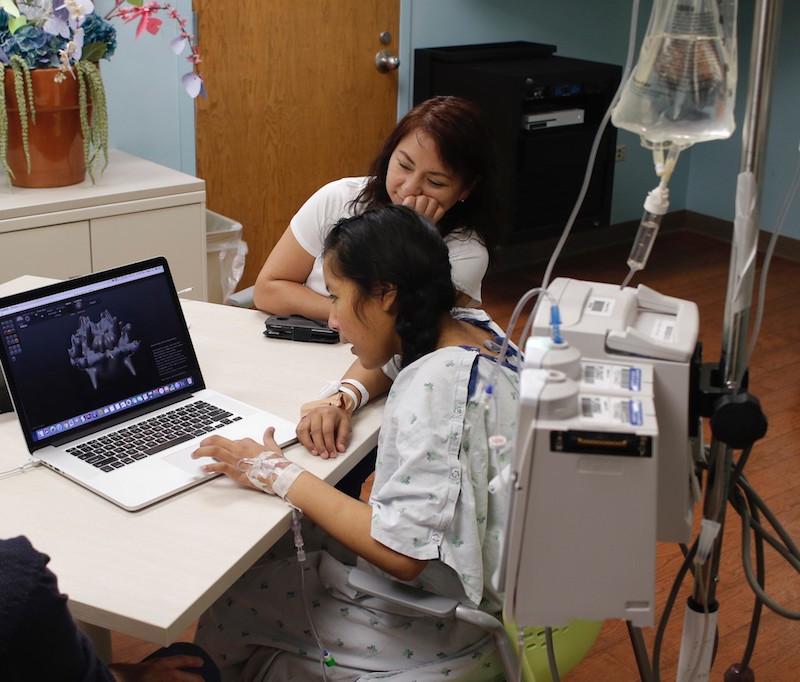Arts and Health During the Time of COVID-19

Music therapist Bianca Hamilton provides environmental music therapy for staff and patients on a COVID unit at Houston Methodist Hospital. Photo courtesy of Houston Methodist Hospital.
“Looking to the arts for solutions inspires our team, but further, we're proud of what that means for the future of arts in health." – Todd Frazier, Director, Center for Performing Arts Medicine, Houston Methodist Hospital
It’s a familiar scene from the COVID-19 pandemic: Patients in hospitals surrounded by machines, beeping alarms, and medical personnel covered by personal protective clothing and masks, with no family members or other loved ones in sight.
The scene in a room at Houston Methodist Hospital, however, has one difference: While lying in his hospital bed, a patient named Ron is looking at an iPad perched on a stand. World-renowned cellist Yo-Yo Ma is on the screen, playing a Bach cello suite and talking directly to Ron about the music. Ron reveals how music relaxes him and takes him away from the hospital, the noise, and the depression he has experienced while hospitalized. “These concerts provide a different dimension to the healing process. Not just physical healing but the enrichment of the soul and the spirit,” he says.
The Center for Performing Arts Medicine (CPAM) at Houston Methodist Hospital facilitated the performance and conversation with Yo-Yo Ma as part of its MUSICARE response, created and led by CPAM Research Scientist Dr. Mei Rui, to the isolation caused by the increased safety restrictions that have prevented COVID patients from receiving visitors. Prior to the pandemic, CPAM provided writing, music, and art-making programs, as well as concerts in public areas for patients and medical personnel delivered by community-based artists throughout the hospital. Once the COVID-19 crisis hit the staff at CPAM had to find new ways to provide arts experiences to patients and staff to help alleviate the stress and isolation they were experiencing.
The same is true of arts in health programs across the country, which have had to find new and creative ways to reach their audiences in healthcare settings. These arts-based programs are a vital part of patient care, as the isolation that patients experience has led to higher levels of depression and anxiety. Hospitals are often eager to provide arts experiences for both their patients and staff to provide much-needed respite.
Through a partnership with the Houston Symphony, CPAM offers live performances for patients in Houston Methodist’s COVID-19, intensive care, and other units throughout the hospital, featuring the symphony’s musicians and special guests like Ma. Through mobile technology, orchestra musicians – mostly strings, piano, and harp – are able to interact with patients via Facebook Live. The musicians play short pieces, ask the listener what songs they might want to hear, and carry on conversations about the music and the feelings that the music evokes. These interactions help take the patient away from their noisy and often windowless environments, helping to provide some ease from the cares and concerns of their medical situation. In addition, the musicians give special performances for medical staff in their break rooms using the same technology, offering moments of peace and reflection to people who are bearing the brunt of the pandemic’s toll.
The hospital also has a robust creative arts therapy program, and the therapists have been included in the patients’ care alongside other treatments and therapies during the lockdown by providing mental health care, breathing therapies, and other medical treatments for both COVID and non-COVID patients. While the creative arts therapists work as part of the medical team in patient treatment plans and outcomes, the CPAM arts and health team provides arts engagement, arts learning opportunities, and respite from the stress and loneliness experienced during hospital stays. Both teams are vitally important for the patients’ health and treatment outcomes.

A young patient participates in a Snow City Arts program using a computer. Photo courtesy of Snow City Arts
While rates of hospitalization for children with COVID-19 are much lower than those of adults, according to the Center for Disease Control and Prevention, children still face hospital stays during which they experience isolation and anxiety. Prior to the pandemic, arts education programs across the country had helped to alleviate these issues and help meet educational goals, but as with adult programs, these bedside interactions have been restricted because of the pandemic.
Snow City Arts (SCA)—a longtime Arts Endowment grantee—is one of many organizations that have worked to find a solution. Founded in 1998, SCA provides arts learning opportunities in the visual arts, creative writing, music, theater, and media arts to children in hospitals and outpatient units throughout Chicago, Illinois. They typically work with healthcare providers and Child Life specialists to provide one-on-one instruction with teaching artists at the bedside as a supplement to the healthcare provided by the medical teams. They also work with the schools attended by hospitalized children to determine the best approach to providing arts education that addresses both arts learning requirements and developmental needs during hospital stays.
After hospitals began shutting down access for outside providers in mid-March, SCA and its team of teaching artists worked with each of its partner hospitals to determine the best methods for serving the students remotely. They decided to enable one-on-one video communication with the students via computers or tablets, and also to provide pre-recorded videos via YouTube to expand their reach. They developed new instruction guides to accompany each workshop with learning objectives, materials, resources, steps, and methods for differentiated instruction. They also provided step-by-step guides and video transcripts to allow students to complete the workshop with or without video instruction, which helps children who do not have access to computers, as well as project kits that include the materials needed to complete the work. SCA has also facilitated opportunities for students to exhibit their visual art and multimedia work in virtual galleries.
Despite the dire circumstances, many organizations are finding silver linings at this time. For SCA it is in the form of new opportunities to reach children who are isolated by the virus. In addition to reaching more hospitalized students through these virtual platforms, the SCA team is also exploring opportunities to reach the many children who are experiencing isolation in their homes, unable to go to school or have access to friends, recreational activities, or arts programs. They are working with schools and community centers to develop curriculum and supplementary materials, using both video learning and text-based materials to serve students who don’t have access to computers.
While organizations such as SCA have been able to successfully pivot to new delivery systems for their programs, they are also incurring new costs, such as having to purchase software that is compliant with HPPA requirements, at a time when hospitals are also facing budget cuts and fee-for-service funding opportunities may be reduced. Despite these challenges, most organizations working at this crucial intersection of arts and health are finding it more important than ever to provide much-needed and much-appreciated arts engagement for adults and children who are isolated in healthcare settings during COVID. Artists are constantly finding ways to reach those who need it most, using the arts to help ease loneliness, reduce stress, bring comfort, and improve health outcomes for those facing health crises.
Beth Bienvenu is the National Endowment for the Arts Director of Accessibility.




